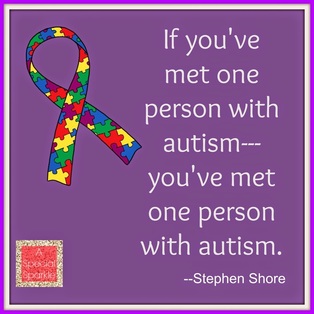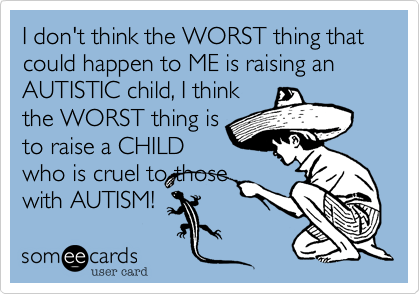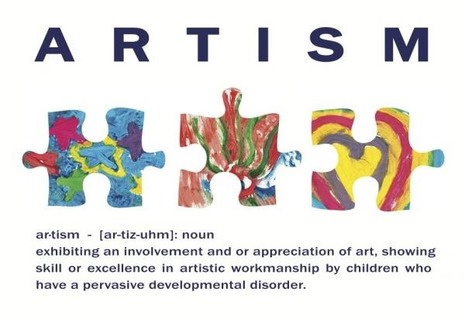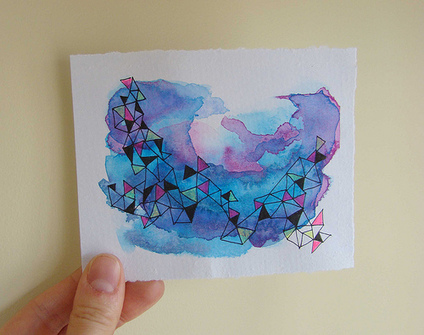Autism and Art

Autism Spectrum Disorder is a neurodevelopmental disorder that affects how people communicate and relate to others. The characteristics of autism varies, but children with autism have difficulty with: communication, social interaction, and restricted interests . There is no cure for autism, but there are specialized interventions to help children with autism. Making art and the creative process can enhance the physical, mental, and emotional well-being of children of all abilities. This page provides resources for teachers, parents, and others who acquire to learn more about teaching art to children with autism. Art may increase the willingness of children with autism to engage in learning because it does not primarily rely on words to communicate feelings or thoughts. Making art can be fun and ultimately, it can also help regulate emotions, senses, and behaviours. This page includes information from various sources to help anyone who wants to better their understanding about teaching art to children with autism. www.autism.net and www.autismcanada.org.
Common Traits of Autism
|
|
Why Make Art?
Why We Make Art and Why It Is Taught (2010) by Richard Hickman
- knowledge and understanding of one’s cultural heritage
- Understanding of one’s inner world - feelings and emotions
- Understanding of the visual world - perceptual training
- Practical problem-solving through manipulation of materials
- Enhancing creativity through development and thinking skills
- Innovation and risk-taking
Teaching Strategies
Visual Aids |
Thematic Areas in Special Education: Experience in Painting and Drawing in Special Education (2014)
The making of art promotes active communication, emotional, playful process which stimulates positive emotions, increasing cognitive, affective and expressive capabilities. Artistic environments help develop self-awareness which helps to create a positive identity and feeling on inclusion. Allow students to interact with artistic environments and view art galleries to enrich their sensory capabilities and to see strategies to help build their artistic skills. |
For visual aids for teaching children with autism please go to the following website Autism.net. The visuals provided on the website are available in both English and French. The website includes videos that demonstrate how each visual aid works, the purpose, and it also has a page where the visual images can be printed of to be used in your classroom. Some of the topics include:
- Classroom Rules
- Visual Schedule
- Cognitive Picture Rehearsal
- Concrete to Abstract
- Teen Organization Chart
- Realization Booklet
- Stop and Listen
- Independence Check-list
- And many more!
Art Activities
www.autismempowerment.org
Group Art:
Because students with autism may need encouragement to develop social skills, group art can help them interact more easily with others in the group. For example, creating a class mural. Alternatively, you can ask students to trace a sketch as the first step of an art project, which can help them interact.
Self-Awareness Art: One that works particularly well with many students with autism involves clipping favorite items from old magazines and making them into an “All About Me” collage. For example, getting students to create a self-portrait as this can improve to having a positive self-image.
Group Art:
Because students with autism may need encouragement to develop social skills, group art can help them interact more easily with others in the group. For example, creating a class mural. Alternatively, you can ask students to trace a sketch as the first step of an art project, which can help them interact.
Self-Awareness Art: One that works particularly well with many students with autism involves clipping favorite items from old magazines and making them into an “All About Me” collage. For example, getting students to create a self-portrait as this can improve to having a positive self-image.
Art Therapy and Autism
Social Skills Program using Art Therapy and Group Therapy for Children on the Autism Spectrum
Summary of this article:
Data Resource Information: The Social Skills Rating System (SSRS) was used to screen and classify children suspected of having social behavioural problems There were also questionnaires for parents and teachers on two sections, social skills and behavioural problems. This instrument was selected by the re- searcher for several reasons. First a child’s demonstrated social skills may vary between school and home, so an instrument that measures both is preferable. Second the SSRS is a standardized, norm-referenced instrument intended for use with typical school children or those with mild disabilities related to social skills, which makes it well suited for the sample at Super- Kids program.
Data Collection: The first phase of the research study was to contact all parents, explain the research study, and request written permission for their child to participate in the study. The second phase of the study was to send out SSrS pretest questionnaires to the parents and teachers of all participating students. The third phase of the study was to send out identical, blank SSrS questionnaires as posttest surveys in late May.
Data Analysis: Hypothesis - Participation in the SuperKids program would improve social skills and the social skills frequency ratings be- tween pre- and posttests, and participation in the SuperKids program would decrease ratings of the frequency of problem behaviours between pre- and posttests.
Discussion:
Summary of this article:
- This article examines social skills therapy program for children ages 11- 18.
- The program uses art therapy and cognitive-behavioural techniques used to helping children with social development disorders to improve their social skill. The results show a significant improvement in behaviours in students through pre- and posttest instruments used by parents and teachers.
- Art therapy offers a different way to communicate and to solve problems visually. An Art therapist can gain insight into what a child is experiencing, and also information that is not available through verbal means. Images, symbols, icons, can help children with autism remember what they were taught. The SuperKid Social Program includes cognitive-behavioural strategies that are used throughout the group therapy session. The specific social skills used by the program include: conversational skills, eye contact, voice modulation, friendship skills, understanding nonverbal/verbal cues, awareness of the environment, expressing feelings, and awareness of others’ feelings. The program also consists of a collaboration school teachers and professionals, psychologists, social workers, and speech and occupational therapists. Art therapy allows children with autism to focus on self-expression in a way that is non threatening.
- A technique commonly used among therapists who teach social skills to children with autism in the use of comic strips. Seeing a image visually is more effective for children with autism in comparison to strategies such as role playing. The act of creating becomes a way of communicating and also enables children to emotionally integrate their personal experiences.
Data Resource Information: The Social Skills Rating System (SSRS) was used to screen and classify children suspected of having social behavioural problems There were also questionnaires for parents and teachers on two sections, social skills and behavioural problems. This instrument was selected by the re- searcher for several reasons. First a child’s demonstrated social skills may vary between school and home, so an instrument that measures both is preferable. Second the SSRS is a standardized, norm-referenced instrument intended for use with typical school children or those with mild disabilities related to social skills, which makes it well suited for the sample at Super- Kids program.
Data Collection: The first phase of the research study was to contact all parents, explain the research study, and request written permission for their child to participate in the study. The second phase of the study was to send out SSrS pretest questionnaires to the parents and teachers of all participating students. The third phase of the study was to send out identical, blank SSrS questionnaires as posttest surveys in late May.
Data Analysis: Hypothesis - Participation in the SuperKids program would improve social skills and the social skills frequency ratings be- tween pre- and posttests, and participation in the SuperKids program would decrease ratings of the frequency of problem behaviours between pre- and posttests.
Discussion:
- Limitations of study: small sample size, parenting styles, economic factors, and level of disability there is also no statistical evidence that art therapy was the key success to the intervention.
- The mean scores for cooperation increased from 9.07 to 9.55. For self-control the scores increased from 10.59 to 10.95.The responsibility scores remained at 12.14 for both pre- and posttest. The summative scores of mean change for all social skills increased from 41.09 to 42.95.
- The article provides proof of evidence of improvement in social skills and resolution of problem behaviours. Statistical evidence-based questionnaires filled out by parents and teachers showed increased social skills in comparison to internalizing behaviours, hyperactivity, and problem behaviours decreased. This is important for children with autism because they have difficulty developing conversational skills and they are often stressed by demands of social interaction that they cannot give or manage. This mental and emotional stress can also cause anxiety. The results shown from the test scores on the SSRS show that children with autism can improve at a faster rate when given specific intervention through programs like SuperKids.
Art Therapy in Newfoundland
www.sensoryart.ca
Christina Dove is a specialist in early intervention strategies and expressive art therapies. She has worked with a variety of different clients with different needs including children with physical, developmental, and cognitive impairments. She is trained in various behavior modification techniques, sensory neural and visual processing strategies. She is a graduate of Memorial University with a Bachelor of Science (hons) in Psychology, a graduate teaching certificate and a Masters in Science in Medicine (Neuroscience) and currently working on a PhD in Community Medicine. She is also a research coordinator of the Infant and Child Vision Research Centre and conducts visual attention and developmental assessments in daycare’s, schools and at MUN. Christina is an expressive arts therapist and a professional member of Canadian art therapy association.
Sensory Art Studios: The aim of this multi-sensory art therapy program is to offer students, whatever their abilities, a wide range of sensory and art activities in a safe and friendly environment.
The program offers three types of art therapy: Individual, group, and family art therapy.
Individual Art Therapy: Individual art therapy sessions are designed to address specific goal areas identified in the first assessment session such as sensory integration, visual processing work, focused and sustained attention, and/or fine and gross motor movement. These sessions also address these goals through a variety of therapeutic sensory art activities such as experimenting with a variety of art textures and mediums. This session provides one-on- one assistance with a therapist and also focuses on goals ,such as creativity and imagination, communication, emotional, social, motor and academic goals are addressed as well.
Group Art Therapy: This session focuses on cooperative play, relational awareness, self-expression, and communication within a small group setting (2-4 participants. A sibling art therapy group is also available.
Family Art Therapy: This session features groups of 2-5 participates in a creative family project including a family murals and sculptures, family collage, photo therapy techniques and printmaking work. This type of session focuses on the engaging, cooperative and playful interaction using the family systems model.
For more information on check out the following website www.sensoryart.ca or contact:
Sensory Art Studios
709-690-9899
[email protected]
Christina Dove is a specialist in early intervention strategies and expressive art therapies. She has worked with a variety of different clients with different needs including children with physical, developmental, and cognitive impairments. She is trained in various behavior modification techniques, sensory neural and visual processing strategies. She is a graduate of Memorial University with a Bachelor of Science (hons) in Psychology, a graduate teaching certificate and a Masters in Science in Medicine (Neuroscience) and currently working on a PhD in Community Medicine. She is also a research coordinator of the Infant and Child Vision Research Centre and conducts visual attention and developmental assessments in daycare’s, schools and at MUN. Christina is an expressive arts therapist and a professional member of Canadian art therapy association.
Sensory Art Studios: The aim of this multi-sensory art therapy program is to offer students, whatever their abilities, a wide range of sensory and art activities in a safe and friendly environment.
The program offers three types of art therapy: Individual, group, and family art therapy.
Individual Art Therapy: Individual art therapy sessions are designed to address specific goal areas identified in the first assessment session such as sensory integration, visual processing work, focused and sustained attention, and/or fine and gross motor movement. These sessions also address these goals through a variety of therapeutic sensory art activities such as experimenting with a variety of art textures and mediums. This session provides one-on- one assistance with a therapist and also focuses on goals ,such as creativity and imagination, communication, emotional, social, motor and academic goals are addressed as well.
Group Art Therapy: This session focuses on cooperative play, relational awareness, self-expression, and communication within a small group setting (2-4 participants. A sibling art therapy group is also available.
Family Art Therapy: This session features groups of 2-5 participates in a creative family project including a family murals and sculptures, family collage, photo therapy techniques and printmaking work. This type of session focuses on the engaging, cooperative and playful interaction using the family systems model.
For more information on check out the following website www.sensoryart.ca or contact:
Sensory Art Studios
709-690-9899
[email protected]
|
|
|
Mindfulness and Autism
Article: Child Behaviour Problems and Parental Well-Being in Families of Children with Autism (2014) by Jones, Leah; Hastings, Richard, Patrick, Totsika, Vasiliki; Keane, Lisa; Rhule, Neisha
Psychological distress in parents of children with Autism:
Purpose: The authors of this article researched to see if there was a relation between child behaviour and parental distress linked with mindfulness.
Method: 71 mothers and 39 fathers of children with autism participated by reporting their positive and negative psychological well-being and their child's behaviour problems. Mostly biological parents, but some foster parents, step parents.
Participants complete questionnaires: demographic questionnaire along with questionnaires measuring child behavioural problems, positive and negative parental well-being, and mindfulness and acceptance.
Researchers found that mindfulness mediated the relation between child behaviour problems and parental well-being. They found that mindful parenting had significant mediation effects in relation to anxiety, depression, and stress. The level of child's behaviour problems was a significant predictor of psychological distress for both mothers and fathers.
Parents who reported increased mindfulness and acceptance also reported greater. The results also showed greater self-compassion and greater empathetic concerns and forgiveness for others. However, further research is needed, especially test reliability and validity. The sample size was small of father participants so caution needed to interpreting results. More research is needed as it is unclear as to whether higher level of mindfulness lead to greater adjustment or whether parents who adjust easily have a tendency to be more mindful and accepting (or both).
Psychological distress in parents of children with Autism:
Purpose: The authors of this article researched to see if there was a relation between child behaviour and parental distress linked with mindfulness.
Method: 71 mothers and 39 fathers of children with autism participated by reporting their positive and negative psychological well-being and their child's behaviour problems. Mostly biological parents, but some foster parents, step parents.
Participants complete questionnaires: demographic questionnaire along with questionnaires measuring child behavioural problems, positive and negative parental well-being, and mindfulness and acceptance.
Researchers found that mindfulness mediated the relation between child behaviour problems and parental well-being. They found that mindful parenting had significant mediation effects in relation to anxiety, depression, and stress. The level of child's behaviour problems was a significant predictor of psychological distress for both mothers and fathers.
Parents who reported increased mindfulness and acceptance also reported greater. The results also showed greater self-compassion and greater empathetic concerns and forgiveness for others. However, further research is needed, especially test reliability and validity. The sample size was small of father participants so caution needed to interpreting results. More research is needed as it is unclear as to whether higher level of mindfulness lead to greater adjustment or whether parents who adjust easily have a tendency to be more mindful and accepting (or both).
Parent Resources

Autism Spectrum Disorder: Concerns, Needs, and Resources of Families
Depression, anxiety, anger and disbelief are common feelings that impact both children ASD and parents' physical psychological health.
Early intervention is important for children with ASD as assessment of resources and support networks that focus on the child's development and the need's of the family.
Article: Self-Compassion and Well-Being in Parents of Children with Autism (2014) by Kristin D. Neff and Daniel J. Faso
Parents of children with autism are faced with difficult daily stressors associated with their child's disorder.
Coping strategies: Self- compassion: Being mindfully aware of negative thoughts and emotions, being kind to oneself in the time of difficultly, recognizing the shared experience of human suffering. This article examine the association self-compassion in 51 parents of a child with autism using self-report measures. Adjusting can be difficult for parents, but results reveal that self-compassion can play a significant role in the well-being of parents. A recent meta-analyses found that parents of autistic children also had higher levels of parenting stress and that the severity of a child's autism symptoms and behaviours has been found as one of the strongest predictors of parental stress.
Another factor impacting parental well-being is shame often experienced by parents of children with autism. For example, parents may receive disapproval from strangers for not being able to "control" their child. Many may assume that the child is just misbehaving. Parents may also feel that they are not making the right treatment choices or taking enough advice from others about what treatments they should use. There may also be feelings of guilt for not doing enough for their child with autism. Mindfulness -Based Interventions have been shown to reduce stress among parents of children with developmental disabilities in general and among parents of children with autism in particular.
Methods:
- The study consisted of biological parents of children with ASD between the ages 4-12. Parents ranged in age from 25 to 54. Most parents had some education (bachelor's degree, graduate, college, or high school diploma). Parents were generally middle-upper class in terms of income.
- Measures: ASD smyptom severity was measured assessed with the Gilliam Autism Rating Scale consisting of a 42-item measure that asks parents to report on on the frequency with which they observe symptoms associated with ASD. The instrument assesses the behavioural symptom severity along a spectrum of difficulties consistent with the Diagnostic and Statistical Manual of Mental Disorders (DSM-5). The scale uses three sub-scales to assess distinct groups of symptoms: social interaction, communication, and stereo- typed behaviours. Higher standard scores for each sub-scale equate to more severe symptoms related to autism, and this measure has shown high reliability and validity when assessing the presence of autism in children. In this study, average symptom severity score was used to assess total impact of behaviour difficulties.
- Participants were also given the Self- Compassion Scale, self-reported, a 26-item measure ranging from 1 to 5. It contains six sub scales: self-kindness, self-judgement, common humanity, isolation, mindfulness, and and over-identification. The scale demonstrates convergent validity (e.g., correlates with partner ratings), discriminate validity (e.g., no correlation with social desirability), and good test-retest reliability. Participants were given the Satisfaction with Life Scale, a five-item self-report scale that measures an individual’s perceptions of current life satisfaction. Using a 7-point scale, parents reported the extent to which they agreed with each statement (e.g., “If I could live my life over, I would change almost nothing".
- Hope was assessed using the Adult Hope Scale, a 12-item measure of an individual’s hope for the future. The scale has two four-item subscales--hope path- ways and hope agency. This study used the reengagement sub- scale of the Goal Disengagement and Goal Reengagement Scale The Goal All items in this six-item subscale are prefaced by the prompt, “If I have to stop pursuing an important goal in my life, ...” then followed by a stem such as “I put effort toward other meaningful goals.” The Reengagement Scale has shown strong validity and reliability across numerous studies and populations.
- Depression To measure the degree of current depressive symptoms, parents completed the Center for Epidemiologic Studies Depression Scale, a 20-item self-report scale measuring depressive symptoms experienced by the parent in the past week. Previous studies have reported good reliability and validity for this measure, as well as high internal consistency. The Parenting Stress Index-Short Form is a 36-item questionnaire designed to measure the stress an individual feels within a parenting role. The PSI-SF consists of three subscales (parental distress, parent-child dysfunctional interaction, difficult child), each containing 12 statements that are rated by parents from 1 to 5. The parental distress subscale contains items that pertain to feeling incompetent, restricted, or isolated in one’s role as a parent.
Results: Table 1 presents the means, standard deviations, and Cronbach’s alpha for all study variables. Table 2 presents the zero-order correlations between variables, including age and sex. Note that autism symptom severity was not linked to age or sex and that self-compassion was significantly associated with age but not sex. Also, having a more severely autistic child does not necessarily lead to the lack of self-compassion. As expected, higher levels of self- compassion were associated with greater well-being among parents of children with autism. Autism symptom severity was significantly linked to depression, parental distress, and relationship dysfunction, but not the three positive outcomes of life satisfaction, hope, or goal reengagement.
In order to determine whether self-compassion predicted well-being beyond that accounted for by autism symptom severity, they conducted a series of regression analyses. An examination of their partial correlations revealed that self- compassion was a significantly stronger predictor of parental distress, while symptom severity and self-compassion did not significantly differ as predictors of relationship dysfunction. They also examined whether behavioral severity and self- compassion interacted when predicting outcomes, and no significant interaction effects were found.The measurements for the following study were used:
1. Symptom severity
2. Self-compassion
3. Life satisfaction
4. Hope
5. Goal reengagement
6. Depression
7. Parental distress
8. Relationship dysfunction
9. Perceived child difficulty
In order to determine whether self-compassion predicted well-being beyond that accounted for by autism symptom severity, we conducted a series of regression analyses. Standardized residuals were created for each variable after regressing out age and sex in order to control for these factors. We then conducted step-wise regressions in which symptom severity was entered in the first step, and self-compassion was entered in the second step (see Table 3). Mirroring what was found for the zero-order correlations, symptom severity significantly predicted depression, parental distress, and relation- ship dysfunction, but not life satisfaction, hope, or goal reengagement. When self-compassion was entered in step 2, significant additional variance was explained for all outcomes. After adding in self-compassion, moreover, symptom severity was no longer a significant predictor of depression. Both self- compassion and symptom severity were significant predictors of parental distress and relationship dysfunction. An examination of their partial correlations revealed that self- compassion was a significantly stronger predictor of parental distress, while symptom severity and self-compassion did not significantly differ as predictors of relationship dysfunction.
Discussion:
This study examined the link between self-compassion and well-being among parents of autistic children and found that parents with higher levels of self-compassion were more emotionally resilient than those with lower levels of self- compassion. General mindfulness and mindful parenting had significant mediation effects for maternal anxiety, depression, and stress. These results contribute to evidence that mindfulness and acceptance may be important parental psychological processes, with implications for parent support.
Services for Parents
Family Support
Autism.net
Autism in Newfoundland
Support for Autism in Newfoundland - Click Link
Autism in Canada
The Autism Society of Canada features information and understandings of ASD, Treatment and Education, Adults & Youth, Professionals, Families and Caregivers. It also features an Arts page for people with ASD that includes an Art Gallery along with Art-related resources. Furthermore, the link for Parents and Caregivers provide tips from parents of children with ASD on the following topics: Home Safety Issues, Wandering/Running Away, Safety with Others, Life at School, Fostering Unique Abilities, and Siblings.
- Social Workers are able to provide support as needed, by discussing any concerns or issues that the family may be encountering and by helping to empower the family to make choices that will be useful for their child. The extent of this involvement will be different for each family. There is also behaviour programs and parent workshops.
Autism in Newfoundland
Support for Autism in Newfoundland - Click Link
- In Newfoundland, there are parent support groups designed to connect parents and to create a network. This group is open to any parents who have children with a variety of challenges and abilities. The purpose of this group is to provide support, resources and a chance to share similar experiences as well as provide guidance and resources. There are support groups developed in many regions throughout Newfoundland, but if you do not see a support group for a particular region then the coordinator Christopher Dedde can be contacted at [email protected].
Autism in Canada
The Autism Society of Canada features information and understandings of ASD, Treatment and Education, Adults & Youth, Professionals, Families and Caregivers. It also features an Arts page for people with ASD that includes an Art Gallery along with Art-related resources. Furthermore, the link for Parents and Caregivers provide tips from parents of children with ASD on the following topics: Home Safety Issues, Wandering/Running Away, Safety with Others, Life at School, Fostering Unique Abilities, and Siblings.
Artists with Autism
|
|
Stephen Wiltshire is a British artist who was diagnosed with autism at the age of three and he did not speak until the age of five. He started drawing at a young age and eventually, he was able to create detailed drawings of landmark buildings and cars from his memory by the age of ten. Drawing is Stephen’s way of communicating to the world.
Stephen Wiltshire Link |
|
|
A 11-year old boy with autism draws detailed world map entirely from memory. A professor in New York invited her 11-year son who has autism to one of her classes, during which he got up on a chair and drew the world map from memory. The map is not only accurate, with some major countries labelled, but with high levels of detail that extends to the inclusion of political borders and even tiny costal islands.
11-year old boy with autism - Link |
|
|
Iris Grace Halmshaw is a child with autism who struggles to communicate to the world, but was able to express herself through art at the young age of three. Her artwork has been compared to famous artists, such as Claude Monet and Jackson Polluck. Iris Grace Link Derek Paravicini who is from Britain has autism and is blind, resulting in his severe learning disability. He begun playing piano at the age of two and eventually, he was able to play many piano pieces at a young age with almost no visuals to guide him. Despite his inability to communicate through language, he has the ability to communicate through sound as he now has performed many concerts all over the world. |




